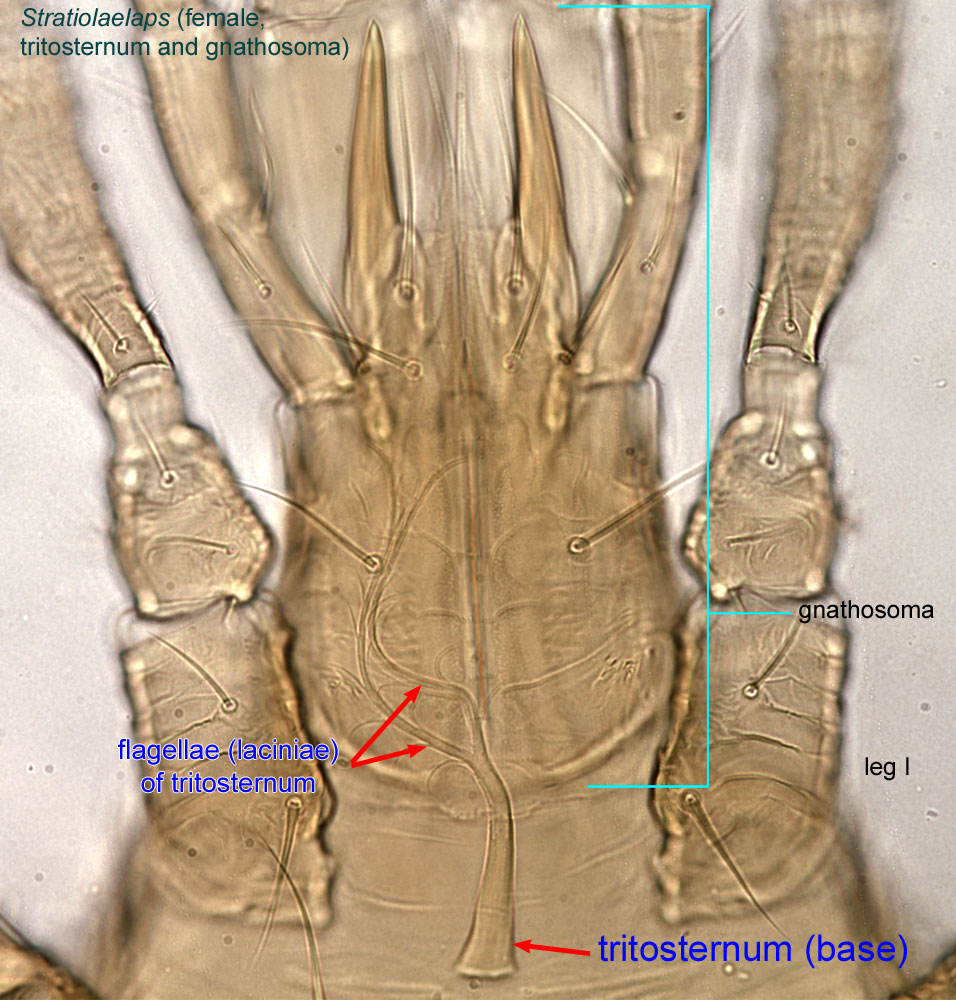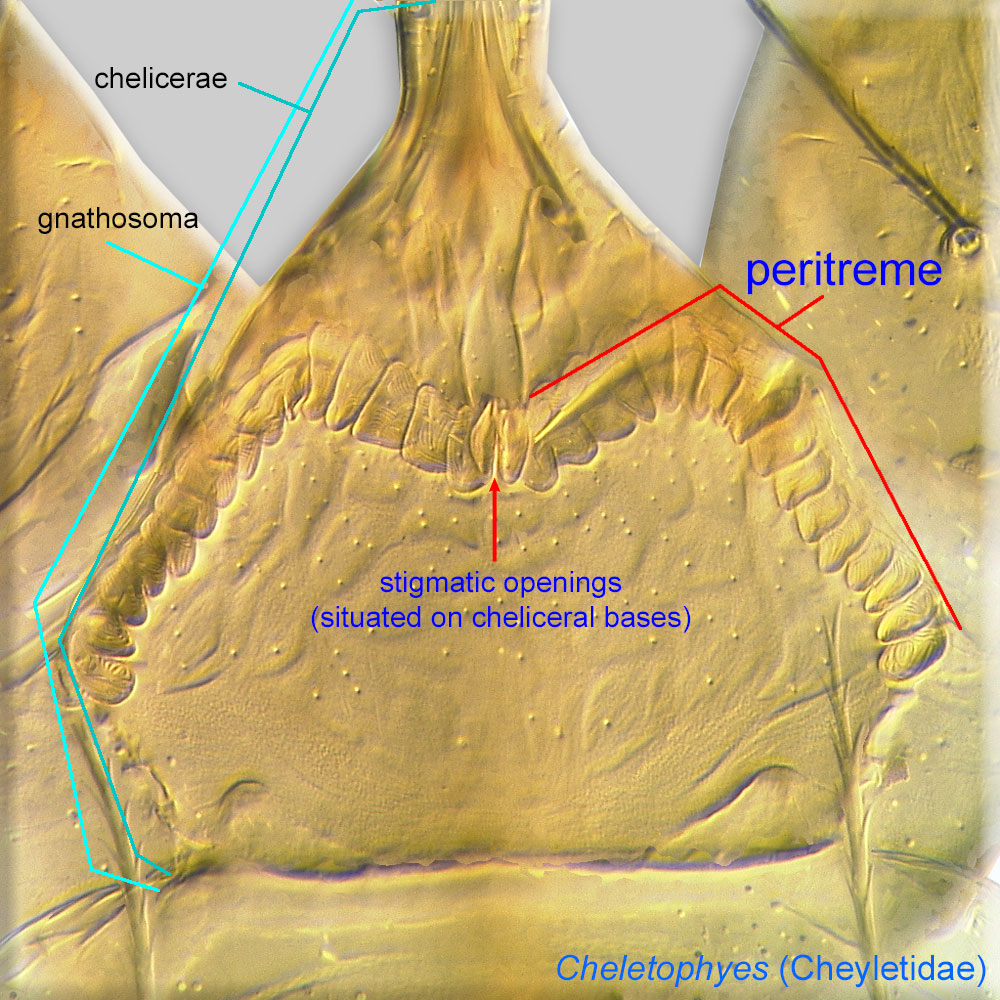possibly kleptoparasitic; suspected to feed on pollen and nectar in bee nests
Stigmatolaelaps Krantz, 1998
Superorder Parasitiformes » Order Mesostigmata » Suborder Monogynaspida » Hyporder Dermanyssiae » Family Laelapidae » Genus Stigmatolaelaps
Hypoaspis greeni Oudemans, 1902, in part
Female: Stigmatic fields enlarged: width of stigmatic field more than twice base of tritosternumtritosternum:
In Mesostigmata, a biflagellate structure situated on the ventral side of the body, posterior to the gnathosoma and anterior to the sternal shield. Sometimes the flagellae (laciniae) are partially or completely fused.  (Figs. 2, 3, 6). PeritremesPeritreme:
(Figs. 2, 3, 6). PeritremesPeritreme:
Paired, tubular, elaborated extensions of a tracheal system associated with stigmatic openings. Can be chambered, arch-like, and situated on the bases of chelicerae as in Cheyletidae (Prostigmata) or, in Mesostigmata, linear and situated on the lateral sides of the body.
 typical, extending anteriorly beyond legs II (Figs. 1, 3). Sternal setae st3 situated on sternal shieldsternal shield:
typical, extending anteriorly beyond legs II (Figs. 1, 3). Sternal setae st3 situated on sternal shieldsternal shield:
A shield in the anterior intercoxal region of parasitiform mites that bears one or more pairs of sternal setae.
 , not extending beyond bases of st4 (Figs. 4, 5). Unpaired setae on posterior opisthosomaopisthosoma:
, not extending beyond bases of st4 (Figs. 4, 5). Unpaired setae on posterior opisthosomaopisthosoma:
Body division posterior to legs IV; usually there is no distinct boundary delimiting this part of idiosoma.
present.
A dichotomous key is available in Krantz, 1998aKrantz, 1998a:
Krantz, G. W. 1998a. A new genus and two new species of hypoaspidine mites (Acari: Laelapidae) associated with old world carpenter bees of the tribe Xylocopini (Hymenoptera: Apidae: Xylocopa). International Journal of Acarology. 24:291-300..
Pneumolaelaps and Xylocolaelaps. Stigmatolaelaps differs from both these genera by its enlarged stigmatic fields that are more than twice the base of tritosternumtritosternum:
In Mesostigmata, a biflagellate structure situated on the ventral side of the body, posterior to the gnathosoma and anterior to the sternal shield. Sometimes the flagellae (laciniae) are partially or completely fused.  (Figs. 2, 3, 6)
(Figs. 2, 3, 6)
tropical Asia
Large carpenter bees of the genus Xylocopa, subgenus Mesotrichia
permanentpermanent:
associated exclusively with bees or their close relative, wasps; cannot live without these hosts
Based on gnathosomal morphology, this genus probably feeds on pollen and adhering substances such as nectar in bee nests (Krantz, 1998aKrantz, 1998a:
Krantz, G. W. 1998a. A new genus and two new species of hypoaspidine mites (Acari: Laelapidae) associated with old world carpenter bees of the tribe Xylocopini (Hymenoptera: Apidae: Xylocopa). International Journal of Acarology. 24:291-300.).
Phoretic phoretic:
Pertaining to phoresy; using another organism (i.e., a host) for dispersal to new habitats. Phoresy can be distinguished from parasitism because feeding typically does not occur during phoresy.
female mites are usually located on the bee body. Occasionally they enter the metasomal acarinariumacarinarium:
A specialized morphological structure that facilitates retention of mites on the body of an organism, typically a bee or wasp.
if it is not fully occupied by larger mites of the genus Dinogamasus (Krantz, 1998aKrantz, 1998a:
Krantz, G. W. 1998a. A new genus and two new species of hypoaspidine mites (Acari: Laelapidae) associated with old world carpenter bees of the tribe Xylocopini (Hymenoptera: Apidae: Xylocopa). International Journal of Acarology. 24:291-300.).